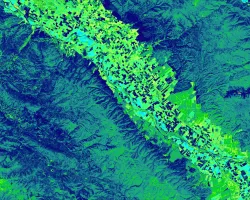Yellowstone Ecological Forecasting II (Fall 2022)
Team: Vanessa Bailey (Project Lead), Ryan Brinton, Samantha Snowden, Aliza White
Summary: Aspen stands in Yellowstone National Park have been indirectly affected by the removal and reintroduction of wolves in 1926 and 1995, respectively. The National Park Service has a strong interest in the trophic cascade of wolves, elk, and aspen due to their ecological importance. In partnership with Yellowstone National Park, Utah State University, and the University of Wisconsin–Stevens Point, this project analyzed data from 1954 and 2021 to determine change in aspen extent at a landscape scale. The team used historical aerial imagery to determine aspen stand extent in 1954 with particular focus on 113 belt transects provided by the team’s partners. To determine aspen stand extent in 2021, the team processed Landsat 8 Operational Land Imager (OLI) and Sentinel-2 Multispectral Instrument (MSI) imagery using a random forest classification. The team then refined outputs with a phenological approach to distinguish between deciduous and evergreen vegetation. The team produced maps of aspen extent for 1954 and 2021. Despite limitations in scales of comparison, the results generally indicate a decline in aspen stand extent over time. This project provides greater context for monitoring aspen stands, understanding the landscape-scale impacts of wolf reintroduction, and communicating the trophic cascade story to the public.



